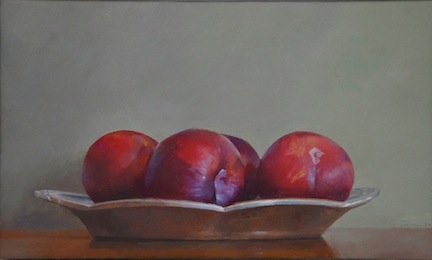Slow and steady
Four Plums is an oil-on-linen still life I’m going to show in the fall at Oxford Gallery, in a two-person show, the first I’ve had there. It’s the sort of thing I want to keep doing as I build a portfolio of work specifically for that show. I’m under the gun a bit, yet I’m changing the way I work as part of my effort to present the best work I can do. I’ve replaced some economy paint with a more expensive line, and I’ve noticed a real difference in the way the paint handles, but I’m still not sure if it’s the quality of the paint or simply the fact that it’s new. The other tubes were getting old, since I use fairly thin layers of oil and a tube can last me years–if it’s a color I don’t favor. If it’s several years old, it thickens and gets harder to use without some dicey thinning. Yet buying the new paint, using better materials, was only part of a larger commitment I’m making to this show in the fall. I’m also resigning myself to taking whatever more time than I might have devoted in the past to finishing a painting properly. What I’m finding is that when I surrender to the natural pace of a given painting, as a way of committing to the best possible outcome, the act of painting will flow the way it should, and I’ll feel more secure about the results as I paint—because I don’t move forward until I’m satisfied with the work I’m doing at the time. I might go back to that area again and again, but if I’m as careful and accurate with it as I can be, from the start, it sets me up for more effective finishing touches later on. I’m not saying I was doing rushed work in the past, but sometimes I would ignore frustration and plow ahead, forcing things, instead of listening to my reactions. I guess all I’m saying is that I’m working in a way that feels more natural to me, rather than trying to paint with a method some other painters I know are using.
There’s some deep connection between the tactile feel of applying paint, in a way where each brush stroke brings a little ping of satisfaction, partly because it’s so carefully considered, that conveys some hard-to-quantify freshness and life in the finished work. It doesn’t make much logical sense that the feel of the activity results in a more convincing look, but that’s what I keep discovering, over the years, and then repeatedly ignoring, when I’m under pressure or impatient to be done. I am putting myself under a self-imposed deadline here, which motivates me to work faster, because I’m hoping to contribute a couple dozen paintings to the show, which means, ideally, I’d like to create maybe eighteen new paintings. I’ve already finished a few, but I still have more than a dozen to paint between now and September. I can do the math and I know how much time I have for each one. Yet it seems that I need to forget the deadlines and try to do only what a good, careful pace requires, which threatens to slow me way down. Here’s the paradox, in the image I’m working on now, of a ceramic bowl, when I slow down and forget about how much of the image I want to finish on a given day—and just focus on getting every stroke done properly, every color applied after long consideration—I begin to see how what I’m doing in one area can be duplicated in another, I spot parallels between a color or value in one part of the object and other parts, and I find myself getting more done than I expected. By ignoring the clock, I discover efficiencies that actually save time. By slowing down, I speed the process. Not always, but I seem to remember a line from the band Genesis back in the 70s: you gotta get in to get out. Something like that seems to be operating in this surrender to the required pace of the work.

I think the tactile feel of the act is much of the appeal of painting to me. Ad that together with the concentration required- it’s similar to sports, like we’ve talked about.
The difference in the quality of paint of various grades is very noticeable- more pigment/tube in professional grades. It is very noticeably, in some colors more than others.
I look forward to the show this fall.
Yep, more paint, less filler. Painting as a physical act: that’s a huge part of it. You get out of your mind: it takes you out of yourself, and much of that gets imparted to a viewer. That one-pointed focus becomes “visible” in a way, in the quality of the painting. Simply looking at a Vermeer gives me a little sample of the focus he had, that empty mind, and that’s a world away from what conceptual art is up to. Not that there’s anything wrong with the conceptual work; it can be powerful and captivating, but not in the same way.